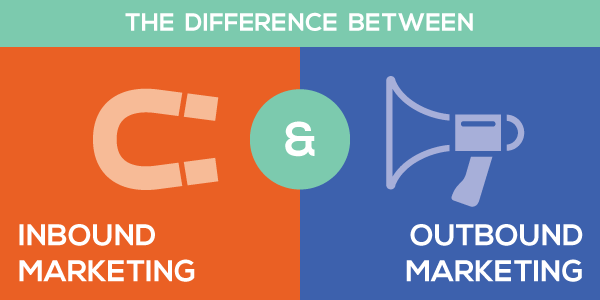The Difference Between Inbound Marketing and Outbound Marketing
Content Marketing

You’ve probably heard it all before: With the Internet constantly evolving every year, marketing has seen its fair share of growth and change. Customers aren’t on televisions or sifting through piles of those holiday direct mail pieces anymore, and they haven’t been for a while. What a customer takes in is on their time, to their preference, within the realm of the Internet.
Consumers are researching products and services, reading reviews, and choosing to subscribe to the type of content they want to read. Those old-school “push” marketing methods that have worked well for so long are seeing a big dip in engagement and interest from every type of customer. What’s formed, instead, is a two-way dialogue, a new marketing communication called Inbound Marketing.
What is Inbound Marketing?
Inbound Marketing is setting up ways for customers to find you. The approach has been really successful for many marketers because it focuses on finding those customers that are already searching for their products and services. Inbound marketing actually costs less than traditional methods because it’s all set online, breaking down and narrowing in on those key interested customers. What makes up inbound marketing is simple: fresh, engaging, targeted content created to attract those online users to your business’s site where they can then learn more about you and possibly make a purchasing decision. Online research is the norm now, where it’s an automatic impulse for customers to do a pre-analysis of a company online before considering a purchase. Inbound marketing focuses on earning, not buying a customer’s attention and it’s done by the following types of strategies:
- Social media marketing
- Interesting, engaging content in the form of blogs, podcasts, and whitepapers.
- Infographics
- Podcasts/Webinars
- eBooks
- Search Engine Optimization (SEO)
- Pay-Per-Click Advertising (PPC)
Take a look at the facts:
- 90% of consumers find custom content useful and 78% believe that organizations providing custom content are interested in building good relationships with them (McMurry/TMG).
- 84% of 25-34 year-olds have left a favorite website because of intrusive or irrelevant advertising (Mashable).
- Companies that spend more than 50% of their lead generation budget on inbound marketing report a significantly lower cost-per-lead (Hubspot).
What is Outbound Marketing?
Outbound marketing is the type of marketing that was mentioned earlier – the old, traditional, “push” methods of marketing. This type of marketing focuses on paying to broadcast a message outward to find consumers who will listen. Outbound is blasting out as many messages as possible to capture the biggest audience in order to generate the highest number of sales. It’s a probability game: the more ads distributed out = more interested people = more sales for your business. Types of outbound marketing strategies include:
- TV ads
- Print ads
- Direct mail
- Tradeshows
- Telemarketing/cold-calling
- Press releases
- Email marketing
Which One Should I Use?
It’s perfectly okay to use both! Just remember that inbound marketing is evolving to be the most effective way for a business to communicate to their customers. Inbound marketing can help a business drive more interested leads to help grow a business’s sales funnel and this can be supplemented with outbound marketing tactics. To be successful with inbound marketing, make sure you have a well-developed website with high-quality content that’s also search engine optimized to help customers search and find you. Be really consistent with posting blogs, engaging on social media, and creating content that users will want to read, watch, or listen to (ebooks, videos, podcasts).
Once you have a good grip on what interests your customers most, you can then disperse some outbound marketing strategies to better target interested customers. Make sure these outbound marketing strategies connect to your inbound marketing. For example, include your website and social media icons on direct mail pieces and flyers. Inbound marketing helps you start a conversation and outbound marketing gets right to the point. Feel free to use both to help take your marketing and advertising strategies to the next level in 2014!
If you’re looking for a great Inbound Marketing software, Hubspot is always a good choice for marketing analytics on entities like websites, blogs, emails, forms, landing pages, calls-to-action, and more.

We’re now a gold-certified preferred Hubspot partner, which means we can help you set up an account and provide you with a winning inbound marketing strategy to go along with it.
About Small Screen Producer
Small Screen Producer is a full service, marketing firm located in Houston, Texas that specializes in online digital media marketing through a 4-step process. Step 1: WE PLAN a custom web presence strategy for your business through website design and development, mobile development, social media account creation and branding. STEP 2: We then POSITION your brand through Pay-Per-Click advertising and search engine optimize tactics that include on-page and off-page SEO that are Google and Bing approved. STEP 3: We then PROMOTE your brand using an Inbound marketing strategy or a content marketing strategy to help you accomplish your marketing goals. We do this through blogging, video production, infographics, call-to-actions, landing pages, and free educational offers. We help you build trust and rapport with your customer base. STEP 4: We then PROTECT your brand’s web presence with a reputation management program that monitors social media and on line reviews. Get started today with a free online marketing assessment of your company’s web presence. Your company deserves it.
